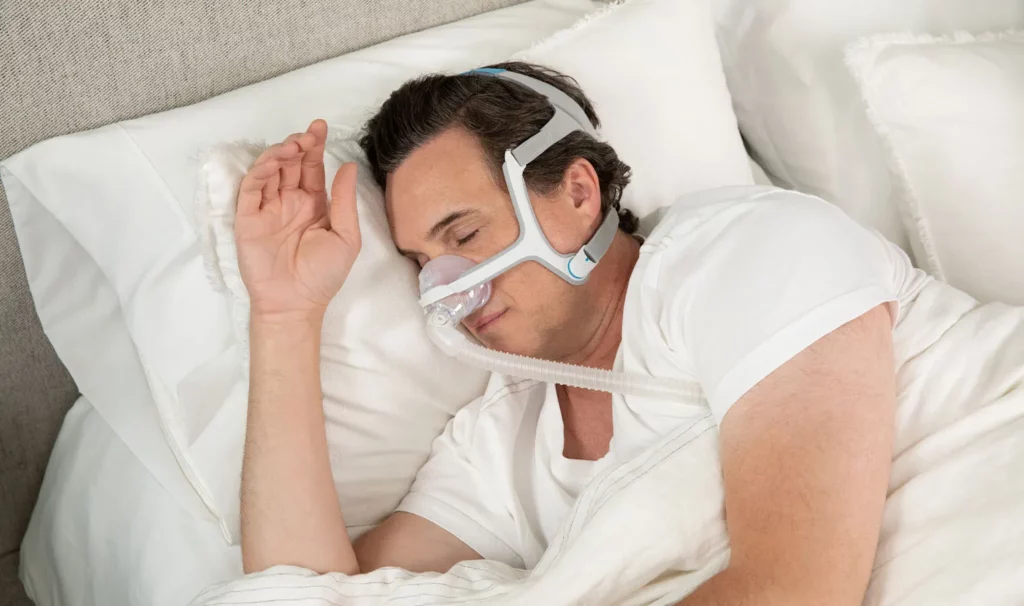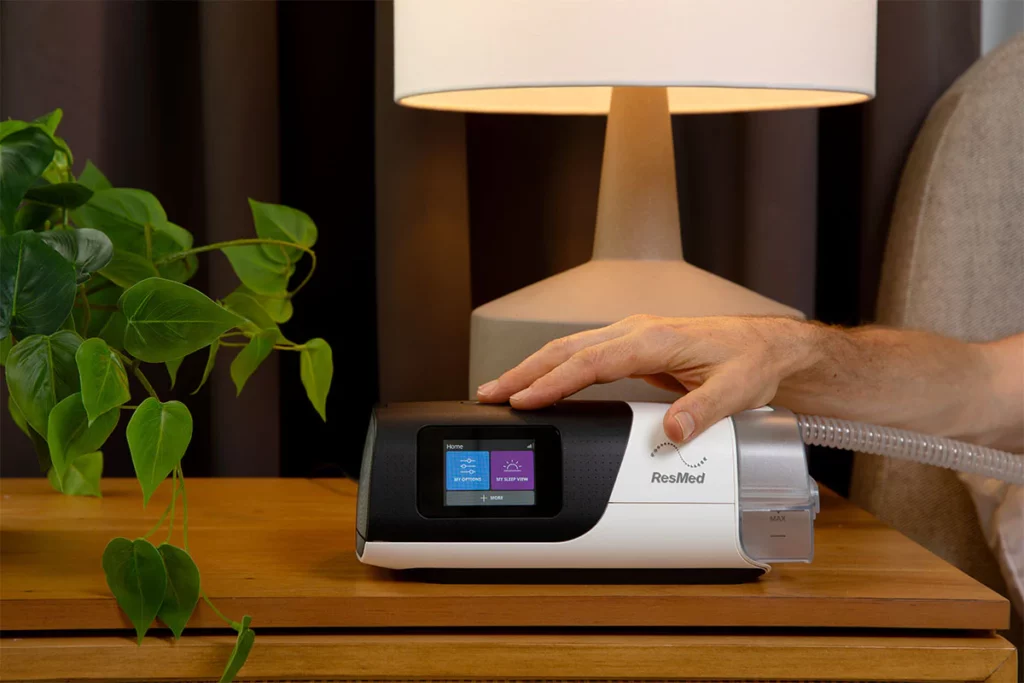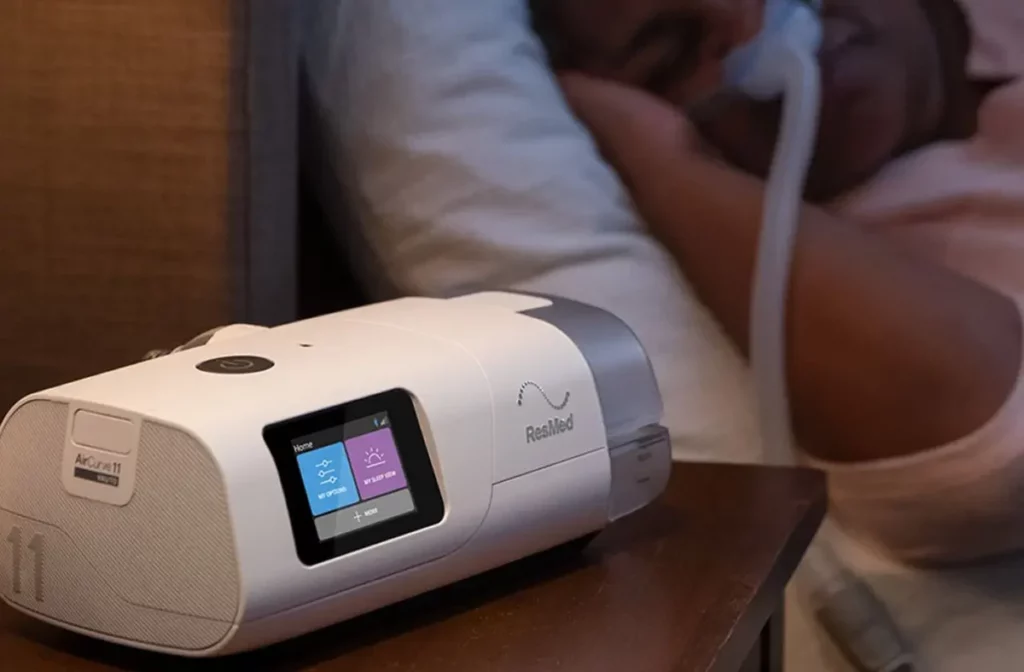Continuous Positive Airway Pressure (CPAP) machines are vital medical devices for individuals diagnosed with sleep apnea. These advanced devices provide a continuous flow of pressurised air through a mask, preventing the airway from collapsing during sleep and allowing users to maintain healthy breathing patterns throughout the night.
Sleep apnea affects millions of people worldwide, making CPAP therapy a crucial treatment for managing this sleep disorder. A properly chosen CPAP machine can significantly improve sleep quality, reduce daytime fatigue, and lower the risk of related health issues.
As a first-time user, selecting the right CPAP machine involves careful consideration of several factors:
- Pressure delivery capabilities
- Mask compatibility
- Comfort features
- Noise levels
- Size and portability
- Data tracking options
This comprehensive buyer’s guide explores the key features and factors that first-time CPAP users should consider. The information provided aims to assist readers in making informed decisions when choosing a CPAP machine that ensures effective therapy and comfortable nightly use.

Understanding CPAP Machines
CPAP (Continuous Positive Airway Pressure) machines are specialised medical devices designed to keep airways open during sleep. They work by delivering a constant flow of pressurised air through a mask, which acts as a splint to prevent the soft tissues in the throat from collapsing—a common cause of obstructive sleep apnea.
How CPAP Machines Work
The main parts of a CPAP machine include:
- Air pump: This component pulls in air from the room and compresses it.
- Air filter: The filter removes dust, allergens, and other particles from the air.
- Humidification chamber: This optional feature adds moisture to the pressurised air for added comfort.
- Tubing: The tubing connects the CPAP machine to the mask.
- Mask: The mask is worn over the nose or mouth and delivers the pressurised air directly to the airway.
Readmore at: How to Choose the Right CPAP Mask for Your Machine and Sleep Style
Health Risks of Untreated Sleep Apnea
If left untreated, sleep apnea can lead to serious health problems:
Short-term Effects
- Persistent daytime fatigue
- Morning headaches
- Difficulty concentrating
- Mood changes
Long-term Complications
- High blood pressure
- Increased risk of heart disease
- Higher likelihood of stroke
- Memory problems
- Risk of type 2 diabetes
How CPAP Machines Help
The pressurised air from CPAP machines prevents these breathing interruptions by keeping the airway open throughout the night. This continuous flow of air ensures that oxygen levels remain stable and reduces the number of apnea events, allowing users to experience deep sleep cycles crucial for overall well-being.
In certain situations, patients may also need additional oxygen while they sleep. For these cases, home oxygen machines can be an effective solution. These devices, such as the Philips Everflo Oxygen Concentrator, are specifically designed for home use and can greatly enhance breathing quality.
Challenges for First-Time Users and How to Overcome Them
Starting CPAP therapy presents several common challenges for new users. Understanding these obstacles and implementing effective solutions helps create a positive therapy experience.

1. Mask Discomfort
- Pressure points on the face
- Skin irritation or redness
- Straps feeling too tight or loose
Solution: Try different mask materials, adjust strap tension, use CPAP-specific moisturiser, or consider mask liners for added comfort.
2. Claustrophobia
- Feeling confined or restricted
- Anxiety about wearing the mask
- Difficulty breathing naturally
Solution: Practice wearing the mask while awake, start with short periods, use relaxation techniques, or opt for minimal-contact masks.
3. Mask Leaks
- Air escaping around mask edges
- Disrupted sleep from noise
- Reduced therapy effectiveness
Solution: Ensure proper mask size through professional fitting, clean mask regularly, replace worn cushions, adjust headgear position.
4. Additional Adjustment Tips
- Use mask fitting guides provided by manufacturers
- Test different mask styles (nasal pillows, full face, nasal)
- Practice proper mask removal technique
- Keep mask clean and well-maintained
- Document issues for healthcare provider discussion
A personalised approach to addressing these challenges proves essential. Each person responds differently to various mask types and adjustment techniques. Working closely with sleep specialists helps identify the most suitable solutions for individual needs.
Key Features to Look for in a CPAP Machine
Selecting the right CPAP machine requires careful consideration of several essential features that impact therapy effectiveness and user experience.
Mask Comfort and Fit
The mask interface serves as the primary connection between the user and the CPAP machine. A properly fitted mask:
- Prevents air leaks that compromise therapy
- Minimises skin irritation and pressure points
- Accommodates different sleeping positions
- Matches individual facial contours
Noise Level
Machine noise can significantly affect sleep quality. Modern CPAP devices typically operate between 24-30 decibels, comparable to a soft whisper. Key noise-related considerations include:
- Sound level ratings below 30 decibels
- Consistent, non-fluctuating noise output
- Distance between the machine and sleeping area
- Impact on bed partner’s sleep quality
Humidification System
Built-in or attachable humidifiers help prevent:
- Dry mouth and throat
- Nasal congestion
- Upper airway irritation
- Morning discomfort
Pressure Settings and Adjustability
Essential pressure-related features include:
- Pressure range appropriate for prescribed settings
- Ramp time options for gradual pressure increases
- Exhale pressure relief for natural breathing
- Automatic pressure adjustment capabilities
Portability Considerations
Travel-friendly features enhance therapy consistency:
- Compact size and lightweight design
- Universal power supply options
- Battery compatibility
- Carrying case availability
Data Recording Capabilities
Modern CPAP machines track therapy effectiveness through:
- Usage hours monitoring
- Leak detection
- Apnea event recording
- Detailed sleep reports for healthcare providers
Exploring Advanced CPAP Machine Options: Auto-CPAP (APAP) Machines with Sensor Technology for Tailored Therapy
Auto-CPAP (APAP) machines are a significant advancement in sleep apnea treatment technology. These sophisticated devices use built-in sensors to monitor breathing patterns and automatically adjust pressure settings throughout the night, delivering personalised therapy for each user.
How APAP Machines Work
The intelligent sensor technology in APAP machines can detect:
- Changes in breathing patterns
- Variations in sleep position
- Episodes of apnea or hypopnea
- Upper airway resistance
This real-time monitoring enables the machine to make precise pressure adjustments within a prescribed range, ensuring optimal therapy delivery at any given moment. When the sensors detect increased airway resistance or potential apnea events, the machine responds by increasing pressure. As breathing stabilises, the pressure decreases accordingly.
Enhancing Therapy Effectiveness with Additional Devices
To further enhance the effectiveness of therapy, incorporating devices such as the Aerobika With Manometer, which allows users to track their pressure in real time, can be beneficial. This device meets OPEP needs and provides valuable insights into pressure management.
The Advantages of APAP Machines
The advantages of APAP machines include:
- Personalised Pressure Delivery: Adapts to nightly variations in breathing patterns
- Enhanced Comfort: Provides only the necessary pressure required at any given time
- Detailed Sleep Data: Records comprehensive information about therapy effectiveness
- Treatment Flexibility: Accommodates changes in sleeping position and seasonal allergies
Who Can Benefit from APAP Machines?
APAP machines particularly benefit patients whose pressure needs vary due to:
- Weight fluctuations
- Alcohol consumption
- Sleep position changes
- Seasonal allergies
- Nasal congestion
Tips for Successful Adaptation to CPAP Therapy: Ramp Settings, Gradual Introduction to Therapy, and Healthcare Provider Consultation
Successful adaptation to CPAP therapy requires a strategic approach focused on patient comfort and gradual acclimation. The ramp settings feature stands as a vital tool in this adaptation process.
Understanding Ramp Settings
Ramp settings allow patients to begin each therapy session at a lower pressure level, which then increases gradually over a predetermined period. This gentle progression helps users:
- Fall asleep comfortably at lower pressures
- Adjust to therapy without feeling overwhelmed
- Build confidence in using the device
- Maintain consistent therapy compliance
Recommended Approach to Utilising Ramp Settings
The recommended approach to utilising ramp settings includes:
- Start Low: Begin with a 15-20 minute ramp time
- Monitor Comfort: Adjust ramp duration based on personal comfort
- Track Progress: Note sleep quality and morning alertness
- Gradual Reduction: Decrease ramp time as comfort improves
The Role of Healthcare Providers
Healthcare providers play a crucial role in optimising ramp settings. They can:
- Analyse sleep data to determine optimal pressure ranges
- Adjust settings based on patient feedback
- Provide guidance on mask fitting
- Monitor therapy effectiveness
Air Liquide Healthcare’s sleep specialists work closely with patients to customise ramp settings according to individual needs, ensuring optimal therapy outcomes through personalised support and regular adjustments.
The Importance of Regular Follow-Up Visits with Healthcare Providers
Regular follow-up visits with healthcare providers play a crucial role in successful CPAP therapy management. These appointments serve multiple essential purposes:
1. Machine Maintenance Requirements
- Filter replacement schedules
- Pressure calibration checks
- Equipment cleaning verification
- Component wear assessment
2. Treatment Effectiveness Monitoring
- Analysis of usage data from machine recordings
- Evaluation of breathing patterns
- Assessment of therapy response
- Pressure setting adjustments as needed
Through data analysis and physical examination of the equipment, healthcare providers can detect potential issues before they become significant problems. These preventive measures help maintain optimal therapy effectiveness and extend the machine’s lifespan.
Insurance coverage requirements often mandate regular check-ups to continue coverage for CPAP therapy. Healthcare providers assist patients by:
- Documenting therapy compliance
- Submitting necessary paperwork
- Addressing insurance-related queries
- Providing supporting medical documentation
Air Liquide Healthcare’s network of 152 diagnostic and therapy service locations across Australia enables convenient access to professional support. Their experienced healthcare providers offer comprehensive maintenance services and treatment monitoring to ensure patients receive maximum benefit from their CPAP therapy.
In addition to CPAP machines, Air Liquide Healthcare also provides portable oxygen concentrators. Regular maintenance checks help identify when machine components need replacement or upgrading, ensuring the equipment continues to deliver prescribed therapy effectively.
Managing Side Effects During Initial Use of CPAP Therapy: Patience, Persistence, and Long-Term Benefits for Improved Quality of Life
The initial adjustment period to CPAP therapy presents specific challenges that patients should anticipate and prepare for. Common side effects include:
- Dry mouth and throat: Using a humidifier attachment can add moisture to the delivered air
- Nasal congestion: Nasal saline sprays or heated humidification help reduce congestion
- Skin irritation: Adjusting mask straps or trying different mask materials, such as those found in our CPAP masks, minimises friction
- Bloating: Proper mask fit and pressure settings reduce air swallowing
- Eye irritation: Addressing mask leaks prevents air from flowing towards the eyes
These side effects typically subside as the body adjusts to therapy. Patients experiencing persistent issues should consult their healthcare provider for personalised solutions.
The long-term benefits of consistent CPAP use far outweigh temporary discomfort:
- Improved sleep quality
- Reduced daytime fatigue
- Lower blood pressure
- Decreased risk of cardiovascular complications
- Enhanced mental clarity and focus
A positive mindset and realistic expectations help patients persist through the adjustment period. Recording improvements in sleep quality and energy levels serves as motivation to maintain consistent therapy use. Healthcare providers at Air Liquide Healthcare offer ongoing support and guidance to ensure successful long-term treatment outcomes.

